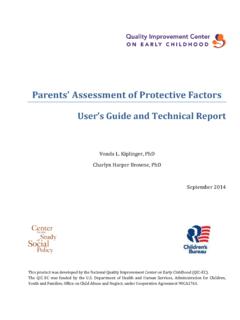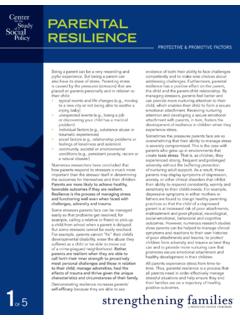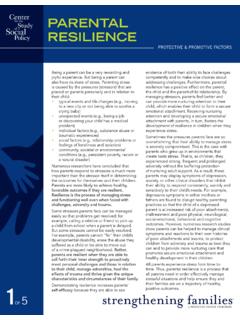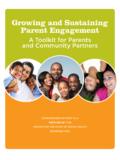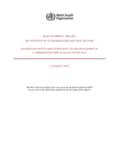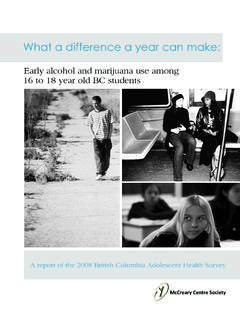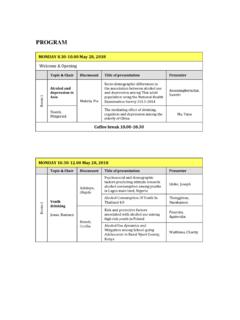Transcription of The Strengthening Families Approach and …
1 The Strengthening Families Approach and protective factors framework : branching Out and Reaching Deepern Charlyn harper Browne, phD nseptemBer 2014 The Strengthening Families Approach and protective factors framework : branching Out and Reaching Deeper 2014, Center for the Study of Social Policy The Center for the Study of Social Policy (CSSP) works to secure equal opportunities and better futures for all children and Families , especially those most often left behind. Underlying all of the work is a vision of child, family, and community well-being. It s a unifying framework for the many policy, systems reform, and community change activities in which CSSP engages. Center for the Study of Social Policy1575 Eye Street, Suite 500 50 Broadway Suite 1504 Washington, DC 20005 New York, telephone fax AcknowledgmentThe author gratefully acknowledges the help of the following individuals in review of this report: Judy Langford, Nilofer Ahsan, and Cailin O Connor, colleagues with the Center for the Study of Social Policy (CSSP), and Juanita Blount-Clark, Anna Lovejoy, and Vicky Marchand, senior consultants with CSSP.
2 This report is in the public domain. Permission to reproduce is not necessary. Suggested citation: Harper Browne, C. (2014, September). The Strengthening Families Approach and protective factors framework : branching out and reaching deeper. Washington, DC: Center for the Study of Social Policy. This report and other documents about the Strengthening Families Approach and protective factors framework are available at n nBackground ..1 National Picture of the Youngest Victims of Child Maltreatment ..2 Establishing the Strengthening Families Approach , Then branching Out ..3 Purpose of This Report ..4 The Foundational Ideas of the Strengthening Families Approach ..6 The Two-Generation Approach .
3 6A Consideration of Culture ..8 The Strengths-Based Perspective ..10 The Biology of Stress ..11 Resilience Theory ..14A Focus on Well-Being ..16 The Nature of Risk and protective factors ..16 The Strengthening Families protective factors framework ..20 Parental Resilience ..21 Social Connections ..26 Knowledge of Parenting and Child Development ..29 Social and Emotional Competence of Children ..36 Concrete Support in Times of Need ..45 The Strengthening Families Approach in Policy and Practice Across the United States ..49 Conclusion ..51 References ..51 Backgroundn n nEarly childhood is considered by many scientists to be the most critical and the most vulnerable developmental period in the lifespan (see, , Brandt, 2014; Brazelton & Greenspan, 2000; National Scientific Council on the Developing Child, 2007a).
4 Burgeoning research in the fields of neuroscience, pediatrics, and developmental psychology has provided much evidence about early childhood as the developmental period in which the foundation for intellectual, social, emotional, and moral development is established (Munakata, Michaelson, Barker, & Chevalier, 2013; National Scientific Council on the Developing Child, 2007a, 2010a, 2010b, 2012a; Shonkoff, 2009). The children in this age group also are subject to the highest rates of child maltreatment1 (Child Trends Data Bank, 2014; Longitudinal Study on Child Abuse and Neglect, ; National Data Archive on Child Abuse and Neglect, 1996-2014; Department of Health and Human Services, Administration for Children and Families , Administration on Children, Youth and Families , Children s Bureau, 2013) and are at the greatest risk of immediate and enduring harm from traumatic experiences like maltreatment (Cohen, Mannarino, & Deblinger, 2006; Felitti, 2002a; Pynoos, Steinberg, & Goenjian, 2007; Scannapieco & Connell-Carrick, 2005; Shonkoff & Garner, 2012; Wiggins, Fenichel, & Mann, 2007.)
5 Ziegler, 2011). But the early years of life also offer the greatest opportunity for preventing or mitigating harm and setting the course for healthy development (Brazelton & Greenspan, 2000; National Research Council and Institute of Medicine, 2000; National Scientific Council on the Developing Child, 2010a; Shonkoff, 2009; Thompson, 2001).The Center for the Study of Social Policy (CSSP) introduced its Strengthening Families Approach and protective factors framework in 2003 as a research-informed, strengths-based initiative for preventing child abuse and neglect in Families of children birth to 5 years old (see Horton, 2003). CSSP s goal was to use findings from field observations, a thorough review of research studies, and advice from prevention and early childhood experts, to formulate an evidence-informed Approach that would reach a broad range of children and Families (Langford, 2011).
6 Many prevention efforts involved responding to maltreatment after it had occurred; thus, the major goal of these child abuse prevention efforts was reducing the likelihood of the recurrence of child abuse and neglect (Paxson & Haskins, 2009; Stagner & Lansing, 2009). CSSP s The Strengthening Families Approach and protective factors framework : branching Out and Reaching Deepern ChArlyn hArPer Browne, PhD n e arly childhood is both the most critical and the most vulnerable time in any child s development. In the first few years, the ingredients for intellectual, emotional, and moral growth are laid down. we cannot fail children in these early years (Brazelton & Greenspan, 2000, p.)
7 X). branching oUt anD reaChInG Deeper 11 Child maltreatment refers to both child abuse and child , however, was consistent with the gradual and still partial shift in the field of child maltreatment (Paxson & Haskins, 2009, p. 4) toward a primary prevention and promotion Approach ; that is, (a) addressing child maltreatment before it occurs; (b) incorporating a focus on increasing protective factors and not singularly on decreasing risk factors ; and (c) promoting healthy family and child outcomes. Stagner and Lansing (2009) supported the idea of primary prevention and promotion efforts:Whereas the traditional response aims to prevent a recurrence of maltreatment once it has already taken place, the new framework focuses on preventing maltreatment from occurring at all.
8 Rather than identifying risk factors for maltreatment and addressing the problems and deficiencies of the primary caretaker, the new framework focuses on Strengthening protective factors and building family and social networks to reinforce the ability of parents to care for their children.. It aims to build on the strengths children have at particular points of the life stage and enhance the social context of the child.. Rather than seeking to minimize harm to the child, it aims to maximize potential to strengthen the capacity of parents and communities to care for their children in ways that promote well-being. (p. 19)national Picture of the youngest Victims of Child MaltreatmentThe federal Child Abuse Prevention and Treatment Act (CAPTA), as amended by the CAPTA Reauthorization Act of 2010, defines child abuse and neglect as, at a minimum, any recent act or failure to act on the part of a parent or caretaker which results in death, serious physical or emotional harm, sexual abuse or exploitation; or an act or failure to act, which presents an imminent risk of serious harm (Child Welfare Information Gateway, 2013, p.)
9 2). The most recent data collected by child protective services agencies through the National Child Abuse and Neglect Data System and reported in Child Maltreatment 2012, provide a national picture of the youngest victims of maltreatment ( Department of Health and Human Services, Administration for Children and Families , Administration on Children, Youth and Families , Children s Bureau, 2013, pp. 19-20) (see text box below).the Strengthening Families protective factors are attributes and conditions that help to keep all Families strong and on a pathway of healthy development and National Picture of the Youngest Victims of Child Abuse and Neglect ( Department of Health and Human Services, Administration for Children and Families , Administration on Children, Youth and Families , Children s Bureau, 2013, pp.
10 19-20)n The youngest children are the most vulnerable to The victimization rate was highest for children younger than 1 year ( per 1,000 children in the population of the same age).n More than one-quarter ( or 181,493) of victims were younger than 3 Twenty percent ( ) of victims were in the age group of 3-5 The percentages of child victims were similar for both boys ( ) and girls ( ).n More than three-quarters ( ) of victims were neglected, percent were physically abused, and percent were sexually In addition, percent of victims experienced such other types of maltreatment as threatened abuse, parent s drug/alcohol abuse, or safe relinquishment of a newborn.
